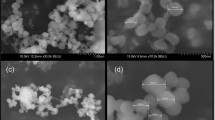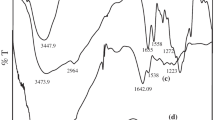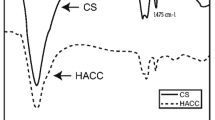ABSTRACT
Purpose
To investigate the effect of polyelectrolytes on the formation and physicochemical properties of chitosan nanoparticles (CS-NPs) used for the delivery of an anticancer drug, doxorubicin (DOX).
Method
Three DOX-loaded CS-NPs were formulated with tripolyphosphate (CS-TP/DOX NPs), dextran sulfate (CS-DS/DOX NPs), and hyaluronic acid (CS-HA/DOX NPs) by using ionotropic gelation or complex coacervation.
Results
CS-TP/DOX NPs were the smallest, with an average size of ~100 nm and a narrow size distribution, while CS-DS/DOX and CS-HA/DOX NPs were ~200 nm in size. Transmission electron microscopy clearly showed a spherical shape for all the NPs. The strong binding affinity of DOX for the multiple sulfate groups in DS resulted in a sustained release profile from CS-DS/DOX NPs at pH 7.4, while CS-HA/DOX NPs exhibited faster DOX release. This trend was also present under acidic conditions, where release of DOX was significantly augmented because of polymer protonation. Compared to CS-TP/DOX or CS-DS/DOX NPs, CS-HA/DOX NPs showed superior cellular uptake and cytotoxicity in MCF-7 and A-549 cells, because of their ability to undergo CD44-mediated endocytosis. Pharmacokinetic studies clearly showed that all CS-NPs tested significantly improved DOX plasma circulation time and decreased its elimination rate constant. Consistent with the in vitro release data, CS-DS/DOX NPs exhibited a relatively better DOX plasma profile and enhanced blood circulation, compared to CS-HA/DOX or CS-TP/DOX NPs. Overall, these results demonstrated how NP design can influence their function.
Conclusions
Taken together, CS-based polyelectrolyte complexes could provide a versatile delivery system with enormous potential in the pharmaceutical and biomedical sectors.










Similar content being viewed by others
REFERENCES
Janes KA, Fresneau MP, Marazuela A, Fabra A, Alonso MJ. Chitosan nanoparticles as delivery systems for doxorubicin. J Control Release. 2001;73:255–61.
Lankalapalli S, Kolapalli VRM. Polyelectrolyte complexes: a review of their applicability in drug delivery technology. Indian J Pharm Sci. 2009;71:481–7.
Bhattarai N, Gunn JJ, Zhang M. Chitosan-based hydrogels for controlled, localized drug delivery. Adv Drug Deliv Rev. 2010;62:83–99.
Park JH, Saravanakumar G, Kim K, Kwon IC. Targeted delivery of low molecular drugs using chitosan and its derivatives. Adv Drug Deliv Rev. 2010;62:28–41.
Malhotra A, Zhang X, Turkson J, Santra S. Buffer-stable chitosan–polyglutamic acid hybrid nanoparticles for biomedical applications. Macromol Biosci. 2013;13:603–13.
Anitha A, Deepa N, Chennazhi KP, Nair SV, Tamura H, Jayakumar R. Development of mucoadhesive thiolated chitosan nanoparticles for biomedical applications. Carbohydr Polym. 2011;83:66–73.
Gan Q, Wang T. Chitosan nanoparticle as protein delivery carrier sys-tematic examination of fabrication conditions for efficient loading and release. Colloids Surf B: Biointerfaces. 2007;59:24–34.
Ravi Kumar MNV, Muzzarelli RAA, Muzzarelli C, Sashiwa H, Domb A. Chitosan chemistry and pharmaceutical perspectives. J Chem Rev. 2004;104:6017–84.
Jonassen H, Kjøniksen AL, Hiorth M. Stability of chitosan nanoparticles cross-linked with tripolyphosphate. Biomacromolecules. 2012;13:3747–56.
Songsurang K, Praphairaksit N, Siraleartmukul K, Muangsin N. Electrospray fabrication of doxorubicin-chitosan-tripolyphosphate nanoparticles for delivery of doxorubicin. Arch Pharm Res. 2011;34:583–92.
He CB, Hu YP, Yin LC, Tang C, Yin CH. Effects of particle size and surface charge on cellular uptake and biodistribution of polymeric nanoparticles. Biomaterials. 2010;31:3657–66.
Liu Z, Jiao Y, Wang Y, Zhou C, Zhang Z. Polysaccharides-based nanoparticles as drug delivery systems. Adv Drug Deliv Rev. 2008;60:1650–62.
Koukaras EN, Papadimitriou SA, Bikiaris DN, Froudakis GE. Insight on the formation of chitosan nanoparticles through ionotropic gelation with tripolyphosphate. Mol Pharm. 2012;9:2856–62.
Agnihotri SA, Mallikarjuna NN, Aminabhavi TM. Recent advances on chitosan-based micro- and nanoparticles in drug delivery. J Control Release. 2004;100:5–28.
Fan W, Yan W, Xu Z, Ni H. Formation mechanism of monodisperse, low molecular weight chitosan nanoparticles by ionic gelation technique. Colloids Surf B: Biointerfaces. 2012;90:21–7.
Nasti A, Zaki NM, Leonardis PD, Ungphaiboon S, Sansongsak P, Rimoli MG, et al. Chitosan/TPP and chitosan/TPP-hyaluronic acid nanoparticles: systematic optimisation of the preparative process and preliminary biological evaluation. Pharm Res. 2009;26:1918–30.
Yousefpour P, Atyabi F, Farahani EV, Sakhtianchi R, Dinarvand R. Polyanionic carbohydrate doxorubicin–dextran nanocomplex as a delivery system for anticancer drugs: in vitro analysis and evaluations. Int J Nanomedicine. 2011;6:1487–96.
Almond A. Hyaluronan. Cell Mol Life Sci. 2007;64:1591–6.
Duceppe N, Tabrizian M. Factors influencing the transfection efficiency of ultra low molecular weight chitosan/hyaluronic acid nanoparticles. Biomaterials. 2009;30:2625–31.
Qadi SA, Meda MA, Zaghloul EM, Taboada P, López CR. Chitosan–hyaluronic acid nanoparticles for gene silencing: the role of hyaluronic acid on the nanoparticles’ formation and activity. Colloids Surf B: Biointerfaces. 2013;103:615–23.
Haidar ZS, Hamdy RC, Tabrizian M. Protein release kinetics for core-shell hybrid nanoparticles based on the layer-by-layer assembly of alginate and chitosan on liposomes. Biomaterials. 2008;29:1207–18.
Bhaskar K, Ravichandiran V, Venkateswarlu V, Rao YM. Lipid nanoparticles for transdermal delivery of flurbiprofen: formulation, in vitro, ex vivo and in vivo studies. Lipids Health Dis. 2009;8:6–18.
Ramasamy T, Ruttala HB, Shanmugam S, Umadevi SK. Eudragit-coated aceclofenac-loaded pectin microspheres in chronopharmacological treatment of rheumatoid arthritis. Drug Deliv. 2013;20:65–77.
Pedroni VI, Schulz PC, Gschaider ME, Andreucetti N. Chitosan structure in aqueous solution. Colloid Polym Sci. 2003;282:100–11.
Huang Y, Lapitsky Y. Salt assisted mechanistic analysis of chitosan/tripolyphosphate micro- and nanogel formation. Biomacromolecules. 2012;13:3868–76.
Gan Q, Wang T, Cochrane C, McCarron P. Modulation of surface charge, particle size and morphological properties of chitosan-TPP nanoparticles intended for gene delivery. Colloids Surf B: Biointerfaces. 2005;44:65–73.
Oyarzun-Ampuero FA, Brea J, Loza MI, Torres D, Alonso MJ. Chitosan–hyaluronic acid nanoparticles loaded with heparin for the treatment of asthma. Int J Pharm. 2009;381:122–9.
Chen Y, Mohanraj VJ, Wang F, Benson HAE. Designing chitosan–dextran sulfate nanoparticles using charge ratios. AAPS PharmSciTech. 2007;8:E98.
Kayal S, Ramanujan RV. Doxorubicin loaded PVA coated iron oxide nanoparticles for targeted drug deliver. Mater Sci Eng C. 2010;30:484–90.
Barret PC, Gustavsson T, Markovitsi D, Manet I, Monti S. Unravelling molecular mechanisms in the fluorescence spectra of doxorubicin in aqueous solution by femtosecond fluorescence spectroscopy. Phys Chem Chem Phys. 2013;15:2937–45.
Kim JO, Kabanov AV, Bronich TK. Polymer micelles with cross-linked polyanion core for delivery of a cationic drug doxorubicin. J Control Release. 2009;138:197–204.
Nogueira DR, Tavano L, Mitjans M, Pérez L, Infante MR, Vinardell MP. In vitro antitumor activity of methotrexate via pH-sensitive chitosan nanoparticles. Biomaterials. 2013;34:2758–72.
Subedi RK, Kang KW, Choi HK. Preparation and characterization of solid lipid nanoparticles loaded with doxorubicin. Eur J Pharm Sci. 2009;37:508–13.
Lin LY, Lee NS, Zhu J, Nyström AM, Pochan DJ, Dorshow RB, et al. Tuning core vs. shell dimensions to adjust the performance of nanoscopic containers for the loading and release of doxorubicin. J Control Release. 2011;152:37–44.
Morrisa GA, Castile J, Smith A, Adams GG, Harding SE. The effect of prolonged storage at different temperatures on the particle size distribution of tripolyphosphate (TPP)–chitosan nanoparticles. Carbohydr Polym. 2011;84:1430–4.
Parajó Y, Angelo I, Welle A, Fuente MG, Alonso MJ. Hyaluronic acid/chitosan nanoparticles as delivery vehicles for VEGF and PDGF-BB. Drug Deliv. 2010;17:596–604.
Cho HJ, Yoon HY, Koo H, Ko SH, Shim JS, Lee JH, et al. Polyethylene glycol-conjugated hyaluronic acid-ceramide self-assembled nanoparticles for targeted delivery of doxorubicin. Biomaterials. 2011;32:7181–90.
Lee HJ, Lee K, Park TG. Hyaluronic acid-paclitaxel conjugate micelles: synthesis, characterization, and antitumor activity. Bioconjug Chem. 2008;19:1319–25.
Upadhyay KK, Bhatt AN, Mishra AK, Dwarakanath BS, Jain S, Schatz C, et al. The intracellular drug delivery and anti tumor activity of doxorubicin loaded poly(γ-benzyl l-glutamate)-b-hyaluronan polymersomes. Biomaterials. 2010;31:2882–92.
De la Fuente M, Seijo B, Alonso MJ. Novel hyaluronic acid–chitosan nanoparticles for ocular gene therapy. Investig Ophthalmol Vis Sci. 2008;49:2016–24.
Arpicco S, Rosa GD, Fattal E. Lipid-based nanovectors for targeting of CD44-overexpressing tumor cells. J Drug Deliv. 2013:860780.
Lu HD, Zhao HQ, Wang K, Lv LL. Novel hyaluronic acid–chitosan nanoparticles as non-viral gene delivery vectors targeting osteoarthritis. Int J Pharm. 2011;420:358–65.
Lee HJ, Park WH, Lee MG. Pharmacokinetic and tissue distribution changes of adriamycin and adriamycinol after intravenous administration of adriamycin to alloxan-induced diabetes mellitus rats. Res Commun Mol Pathol Pharmacol. 1995;89:165–78.
ACKNOWLEDGMENTS AND DISCLOSURES
This research was supported by the National Research Foundation of Korea (NRF) grant funded by the Ministry of Education, Science and Technology (No. 2012R1A2A2A02044997 and No. 2012R1A1A1039059).
Author information
Authors and Affiliations
Corresponding authors
Electronic supplementary material
Below is the link to the electronic supplementary material.
ESM 1
(DOCX 1569 kb)
Rights and permissions
About this article
Cite this article
Ramasamy, T., Tran, T.H., Cho, H.J. et al. Chitosan-Based Polyelectrolyte Complexes as Potential Nanoparticulate Carriers: Physicochemical and Biological Characterization. Pharm Res 31, 1302–1314 (2014). https://doi.org/10.1007/s11095-013-1251-9
Received:
Accepted:
Published:
Issue Date:
DOI: https://doi.org/10.1007/s11095-013-1251-9




